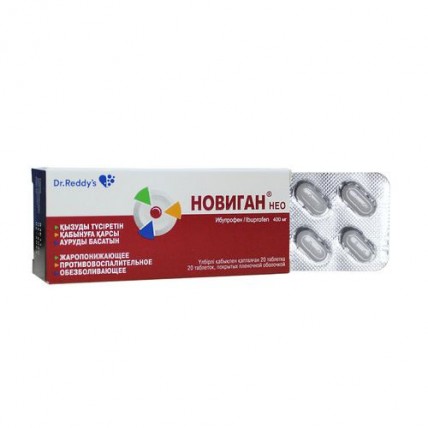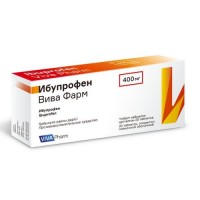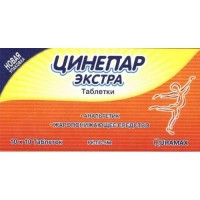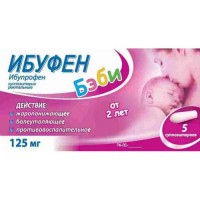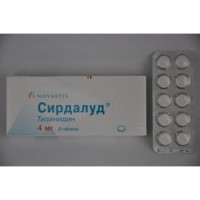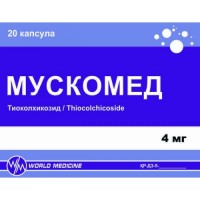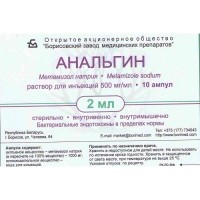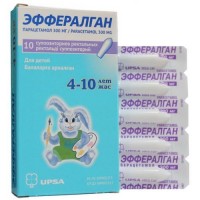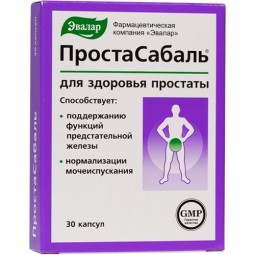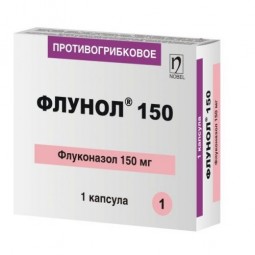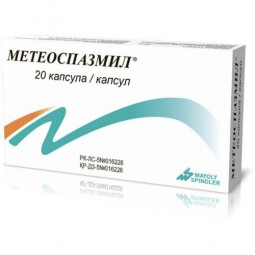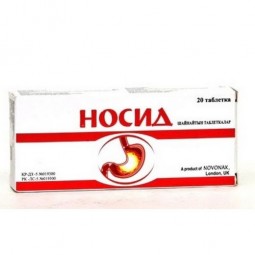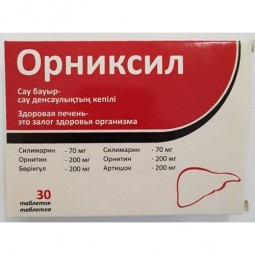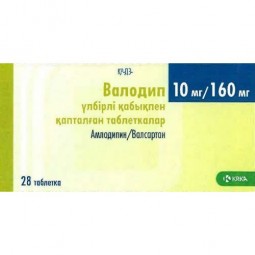Novigan Neo 20s 400 mg coated tablets
- $4.80
The instruction for medical use of Novigan Neo Torgovoye medicine a name Novigan Neo the International unlicensed name Ibuprofen Dosage Form of the Tablet, film coated 400 mg Structure One tablet contains active agent - an ibuprofen of 400 mg excipients: structure of a kernel: microcrystalline cellulose, sodium of a kroskarmelloz, tricalcium phosphate, povidone, gipromelloza, stearic acid, talc structure of a cover: a gipromelloza, a macrogoal 6000, talc, the titan dioxide (E 171) the Description of the Tablet, film coated white or almost white color, oblong shape, with a biconvex surface, with marking of I400 on one party. Pharmacotherapeutic group Anti-inflammatory and antirheumatic drugs. Non-steroidal anti-inflammatory drugs. Propionic acid derivatives. Ibuprofen. ATH code: M01AE01 Pharmacological Pharmacokinetics Absorption properties: At intake the ibuprofen is partially soaked up already in a stomach, and then completely in a small intestine. At oral administration of a dosage form with usual release the peak concentration in plasma is reached in 1 - 2 hour. Distribution: Linking with proteins of plasma makes about 99%. Biotransformation: The ibuprofen is metabolized in a liver (hydroxylation, carboxylation). Removal: Pharmacological inactive metabolites are completely removed, mainly, with urine (90%) and also with bile. Elimination half-life at the healthy people and patients having diseases of a liver and kidneys makes 1.8-3.5 hours. Linearity/nonlinearity: At doses from 200 to 400 mg the linear kinetics of an ibuprofen was observed. At higher doses the nonlinear kinetics of drug was observed. Pharmacodynamics action Mechanism: An ibuprofen - the non-steroidal anti-inflammatory drug possessing the effective action based on prostaglandin synthesis suppression what results of traditional researches on animals testify to. At the person the ibuprofen possesses febrifugal action, reduces pains of inflammatory character and hypostases. Besides, the ibuprofen suppresses the aggregation of thrombocytes caused by ADF and collagen. Clinical performance and safety: Experimental data demonstrate that at simultaneous use with an ibuprofen the effect of inhibition of impact of small doses of acetylsalicylic acid on aggregation of thrombocytes can be observed. During one research when the single dose of an ibuprofen of 400 mg was accepted in 8 hours prior to or in 30 minutes after reception of a dose of instant aspirin (81 mg), weakening of impact of acetylsalicylic acid on formation of thromboxane or on aggregation of thrombocytes was observed. However insufficiency of these data and uncertainty concerning applicability of the data obtained as a result of the researches ex Vivo to clinical conditions, give the grounds to believe that concerning regular reception of an ibuprofen the final conclusions cannot be drawn, and at irregular reception any clinically significant effects are considered as improbable. It is proved that antipyretic action of an ibuprofen comes within 15 min. after administration of drug and lasts till 8 o'clock. Indications - head, a toothache and other types of pain - migraine - neuralgia - muscular pains and joint pains in a pseudorheumatism - symptomatic therapy of cold and flu the Route of administration and doses Drug is intended only for short-term use inside, the tablet needs to be washed down with water. Adults and teenagers with body weight from 40 kg (12 years and above). To take one pill with water to 3 times a day. Drug should be used in time or after a meal. An interval not less than 4 h between the accepted doses and not to take more than 3 pill during any 24-hour period. If children and teenagers aged from 12 up to 18 years need more than 3 days of use of this medicine or if symptoms worsen, it is necessary to consult with the doctor. Adults have to consult with the doctor if symptoms remain or worsen, or use of this product for more than 10 days is required. It is proved that antipyretic action of an ibuprofen comes within 15 min. after administration of drug and lasts till 8 o'clock. The interval between receptions depends on symptomatology and the maximum daily dose, it is not recommended to repeat reception earlier, than in 6 hours. Only for short-term therapy! In the presence of the complaints proceeding within more than 3 days at children and teenagers, more than 3 days at treatment of heat or 4 days at treatment of pains at adults it is necessary to see a doctor. Novigan Neo it is necessary to accept, without chewing and washing down with a large amount of liquid, in time or after a meal. The patient with diseases of digestive tract Novigan Neo at meal time is recommended to accept. Manifestation of side effects can be minimized, using the smallest effective dose with the smallest duration of use necessary for improvement of a state. Special groups of patients Elderly patients of Special dose adjustment it is not required. At elderly patients especially careful control of a state because of possible side effects is necessary. The renal failure For patients with renal failures easy and moderate severity is not required to reduce a drug dose. Use of drug for patients with a renal failure of heavy degree is contraindicated. The liver failure In an abnormal liver function easy and moderate severity of a dose decline is not required. Use of drug for patients with a heavy abnormal liver function is contraindicated. Children and teenagers Drug is not intended for use for children up to 12 years. If intake of this drug by children is more senior than 12 years and teenagers is necessary within more than 3 days, or symptoms are aggravated, it is necessary to see a doctor. Side effects by the Most often observed undesirable phenomena of drug are reactions from digestive tract. Side reactions have dose-dependent character. The risk of developing of gastrointestinal bleeding depends on the range of doses and duration of treatment. Clinical trials show that use of an ibuprofen especially in high doses of 2400 mg/days can be connected with small increase in risk of arterial trombotichesky complications (for example, a myocardial infarction or a stroke). Undesirable side reactions, distribution on occurrence frequency: very often (≥ 1/10), it is frequent (≥1/100 and ≤1/10), infrequently (≥1/1000 and ≤ 1/100), is rare (≥1/10000 and ≤ 1/1000), is very rare (≤ 1/10000). to see immediately a doctor. Klassinfiksation of the system of bodies Frequency Side reaction of Disturbance from blood and lymphatic system Very seldom: Disturbances of a krovoobrazovaniye of Disturbance from the immune system Infrequently Very seldom Reactions of hypersensitivity, including urticaria and an itching. Heavy reactions of hypersensitivity which symptoms can include edema of face language and a throat, short wind, tachycardia, arterial hypotension, anaphylactic reactions, a Quincke's disease, or heavy shock of Disturbance from nervous system Infrequently, very seldom the Headache aseptic meningitis of the Heart disease Is unknown Heart failure and cardiac hypostasis Vascular diseases It is unknown the Disturbance Hypertension from a respiratory system It is unknown the Hyperreactivity of airways including asthma, a bronchospasm or dispnoe Diseases of digestive tract It is Infrequently Seldom Very seldom unknown Stomach aches, nausea, digestive tract disorders Diarrhea, a meteorism, a constipation and vomiting the Peptic ulcer of a stomach, zhelu-dochno-perforation or gastrointestinal bleedings, a melena and a hematemesis. Stomacace, gastritis Exacerbation of colitis and Crohn's disease of Disturbance from a gepatobiliarny system Is very rare the Disturbance Abnormal liver function from skin and hypodermic cellulose Infrequently Severe forms of skin reactions, including Stephen-Johnson's syndrome, multiformny Erie celluloses a subject and a toxic epidermal necrolysis of Disturbance from kidneys and an urinary system Very seldom Acute disorder of function of kidneys Laboratory researches Is very rare Decrease in level of hemoglobin of the Contraindication - hypersensitivity to active ingredient or any of excipients - existence in the anamnesis of reactions of a bronchospasm, asthma, rhinitis or urticaria after intake of acetylsalicylic acid or other non-steroidal anti-inflammatory drugs - disturbances of a hemopoiesis of not clear origin - existence in the present or in the past of a recurrent round ulcer / bleedings (two or more separate episodes of the confirmed peptic ulcer or bleedings) - existence in the anamnesis of gastrointestinal bleeding or perforation of an ulcer, connected with the therapy appointed earlier non-steroidal anti-inflammatory drugs, - the cerebrovascular bleeding or other bleeding which is available now - heavy renal failures or a liver - heavy heart failure - the third trimester of pregnancy - children weighing less than 40 kg (children's return up to 12 years) Medicinal interactions It is necessary to avoid combined use of an ibuprofen with medicinal a preparatma: Other NPVP, including selection inhibitors of cyclooxygenase-2: the concomitant use of several NPVP can increase risk of side reactions Acetylsalicylic acid (in a dose exceeding 75 mg a day): Increases risk of emergence of side reactions. Experimental data demonstrate that at simultaneous use with an ibuprofen the effect of inhibition of impact of small doses of acetylsalicylic acid on aggregation of thrombocytes can be observed. However the limitation of these data and also uncertainty concerning data transfer received by ex Vivo on a clinical situation, do not allow to draw unambiguous conclusions of rather regular use of an ibuprofen, and in case of its irregular use clinically significant reactions are represented improbable the Ibuprofen should be used with care in combination with: Corticosteroids: the increased risk of appearance of ulcers and bleedings in a digestive tract Antihypertensive drugs and diuretics: NPVP can reduce medical effect of these drugs. At some patients with impaired renal function (for example, patients with dehydration or elderly patients of advanced age with impaired renal function) simultaneous use of APF inhibitor or the antagonist of angiotensin II and drugs inhibiting cyclooxygenase can lead to further deterioration in function of kidneys, including a possible acute renal failure which usually has reversible character. Therefore it is necessary to appoint such combinations with care, especially to patients of advanced age. In need of long-term treatment it is necessary to carry out adequate hydration of the patient and to consider a question of carrying out monitoring of function of kidneys at the beginning of the combined treatment and also with a certain frequency further. Diuretics can increase risk of nephrotoxic influence of NPVP Anticoagulants: NPVP can enhance effect of such anticoagulants as warfarin. Antithrombocytic means and selective serotonin reuptake inhibitors (SSRI): the increased risk of developing of gastrointestinal bleeding. Cardiac glycosides: NPVP can strengthen symptoms of heart failure, reduce function of glomerular filtration of kidneys and increase the level of glycosides in blood plasma. Lithium: there are proofs of potential increase in level of lithium in blood plasma. Methotrexate: there is a probability of increase in level of a methotrexate in blood plasma. Cyclosporine: the increased risk of nephrotoxicity. Mifepristone: NPVP should not be applied earlier, than in 8–12 days after mifepristone use as they can reduce its efficiency. Takrolimus: increase in risk of nephrotoxicity at simultaneous use of NPVP with takrolimusy is possible. Zidovudine: the increased risk of hematologic toxicity at use of a zidovudine in combination with NPVP. There are proofs of increase in risk of developing a hemarthrosis and a hematoma at HIV-positive patients with hemophilia — in case of the combined treatment by a zidovudine and an ibuprofen. Hinolonovy antibiotics: The data obtained owing to testing of drug for animals show that use of NPVP can increase risk of the spasms connected with use of hinolonovy antibiotics. At patients who at the same time apply an ibuprofen and hinolonovy antibiotics the increased risk of developing of spasms is possible. Special instructions Undesirable effects can be minimized, using the lowest effective dose during the shortest term necessary for control of symptoms. At patients of advanced age the increased frequency of side reactions on NPVP, especially gastrointestinal bleedings and perforation which can be lethal is observed. Influence on respiratory organs At patients with bronchial asthma or allergic diseases can arise a bronchospasm. Other non-steroidal anti-inflammatory drugs (NPVP) It is necessary to avoid simultaneous use of an ibuprofen with other NPVP, including selection TsOG-2 inhibitors. A system lupus erythematosus and the mixed disease of connective tissue: A system lupus erythematosus and the mixed diseases of connective tissue - the increased risk of aseptic meningitis. Influence on kidneys Risk of developing of a renal failure in connection with further deterioration in function of kidneys. There is a risk of a renal failure at children and teenagers in dehydration. Influence on a liver of the Abnormal liver function. Influence on a cardiovascular and cerebrovascular system Patients with a hypertension, and/or heart failure should begin with care treatment (consultation of the doctor or druggist is necessary) as at therapy of NPVP it was reported about cases of a delay of liquid, a hypertension and hypostases. Results of clinical trial demonstrate that use of an ibuprofen, especially in high doses (2400 mg/days) can lead to increase in risk of emergence of arterial trombotichesky complications (for example, a myocardial infarction or a stroke). In general, data of epidemiological researches do not assume that use of an ibuprofen in a low dose (for example, ≤1200 mg/days) can lead to increase in risk of developing of arterial thrombosis. At patients with an uncontrollable hypertension, stagnant heart failure (NYHA II-III) the coronary heart disease was noted, a disease of peripheral vessels and/or vessels of a brain, a disease it is necessary to treat only by means of use of an ibuprofen after thorough examination, and it is necessary to avoid high doses (2400 mg/days). Special attention also should be paid prior to long treatment of patients with risk factors of developing cardiovascular diseases (for example, a hypertension, a lipidemia, diabetes, smoking), especially if use of an ibuprofen in high doses (2400 mg/days) is necessary. Patients should appoint influence on digestive tract of NPVP with care with digestive tract diseases in the anamnesis (ulcer colitis, Crohn's disease), in connection with possible exacerbation of a disease. There are messages about cases of gastrointestinal bleeding, perforation, an ulcer which can be lethal, NPVP arising at any stage of treatment, irrespective of existence of precautionary symptoms or existence of heavy disturbances from bodies of the digestive tract (DT) in the anamnesis. The risk of developing of gastrointestinal bleeding, perforation or ulcer increases at increase in doses of NPVP at patients with presence of the ulcer in the anamnesis which is especially complicated by bleeding or perforation and also at elderly people. These patients should begin treatment with small doses. To patients with presence of gastrointestinal diseases in the anamnesis, first of all to elderly people, it is necessary to report about any undesirable symptoms from a GIT (especially about gastrointestinal bleeding), in particular, at initial stages of treatment. It is necessary to be careful at treatment of the patients who are at the same time using the accompanying drugs which can increase risk of formation of ulcers or bleeding, such as oral corticosteroids
anticoagulants (for example, warfarin), selective serotonin reuptake inhibitors or antithrombocytic means (for example, acetylsalicylic acid). In case of gastrointestinal bleeding or an ulcer at the patients receiving an ibuprofen, treatment should be stopped immediately. Skin reactions Very seldom against the background of use of NPVP can arise severe forms of skin reactions which can be lethal, including exfoliative dermatitis, Stephens's syndrome — Johnson and a toxic epidermal necrolysis. The high risk of these reactions exists at the beginning of therapy, in most cases such reactions began within the first month of treatment. At the first symptoms of skin rash, pathological changes of a mucous membrane or any other signs of hypersensitivity it is necessary to stop use of an ibuprofen. Recommendations for the patients who are on a controlled sodium diet ≥ 1 tablets a day: This medicine contains 1.09 mmol (or 25.1 mg) sodium in 1 dose (1 tablet) that should be considered when prescribing drug to patients to whom the diet with the low content of sodium is shown. Fertility there Are limited proofs that drug can suppress synthesis of cyclooxygenase/prostaglandin and lead to decrease in female fertility owing to influence on an ovulation. This phenomenon is reversible at the treatment termination. Pregnancy and the period of a lactation Oppression of synthesis of prostaglandins can have negative effect on pregnancy and/or development of an embryo/fruit. Data of epidemiological researches indicate the increased risk of an abortion, congenital malformations after use of inhibitors of synthesis of prostaglandins at an early stage of pregnancy. It is considered that the risk increases with increase in a dose and duration of therapy. The absolute risk of cardiovascular malformations was increased with less than by 1%, up to about 1.5%. The risk as believe, increases at increase in a dose and duration of therapy. At animals, administration of inhibitor of synthesis of prostaglandins as it was shown, leads to increase in risk pre- and post-implantation loss and lethality of an embryo. Besides, increase in number of cases of various malformations, including a cardiovascular system, was registered at the animals receiving inhibitor of synthesis of prostaglandins during the organogenesis period. It is necessary to avoid use of an ibuprofen during the I and II trimesters of pregnancy if there is no obvious need. If the nurofen is used by the woman planning pregnancy or during the first and second trimester of pregnancy, the dose has to be lower, and treatment duration - as it is possible well. In the III trimester of pregnancy all inhibitors of synthesis of prostaglandin can make the following risks: for a fruit: - kardiopulmonarny toxicity (which is characterized by premature closing of an arterial channel and pulmonary hypertensia), - disturbance of functions of kidneys which can progress to a renal failure which is followed oligogidramniony, for mother and the newborn at the end of pregnancy: - increase in a bleeding time, antithrombocytic effect which can develop even at very low doses is possible, - oppression of reductions of a uterus that leads to a delay or increase in duration of childbirth. Drug an ibuprofen is contraindicated in the third trimester of pregnancy. Lactation / Feeding by a breast: Use in the period of a lactation, is found an ibuprofen in breast milk in very low concentration and it will hardly influence negatively children when breastfeeding. Influence on ability of driving or potentially dangerous mechanisms At administration of drug Novigan Neo in high doses such undesirable effects from the central nervous system are possible as increased fatigue and dizziness therefore disturbance of reaction is in some cases possible, abilities to drive the car and to work with mechanisms. The specified phenomena amplify at a drug combination to alcohol intake. Overdose At children the symptoms can arise after reception of the dose exceeding 400 mg/kg of body weight. At adults the dose-dependent effect is less significant. Elimination half-life of drug at overdose makes 1.5 — 3 hours. Symptoms: at most of the patients who used clinically significant doses of NPVP, symptoms of overdose are limited to nausea, vomiting, pains in epigastriums or, more rare, diarrhea. Emergence of such symptoms as sonitus, a headache and gastrointestinal bleeding is possible. In more hard cases manifestations of toxicity from the central nervous system are observed, in particular, drowsiness, occasionally – excitement and also a disorientation or a coma, in rare instances arise spasms. In cases of a serious poisoning the metabolic acidosis and increase in a prothrombin time can develop that is probably connected with interaction of drug and the circulating blood-coagulation factors. The acute renal failure and injury of a liver can develop. At patients with bronchial asthma the exacerbation of this disease is possible. Treatment: gastric lavage, oral administration of activated carbon, if necessary the symptomatic and supporting treatment with obligatory ensuring free passability of airways, monitoring of warm activity and key indicators of activity before normalization of a condition of the patient. Frequent or long spasms should be stopped intravenous administration of diazepam or lorazepam. In bronchial asthma the use of bronchodilators is recommended. The form of release and packing On 10 tablets place in blister strip packaging from a white rigid film of a polyvinylchloride and soft foil aluminum, vignette paper. On 1 (2 or 3) blister strip packagings together with the instruction for medical use in the state and Russian languages put in a pack cardboard. Storage conditions In the dry, protected from light place at a temperature not over 25 of 0C. To store out of children's reach! Period of storage 3 years. Not to apply after an expiration date. Prescription status According to the prescription the Producer Laboratorios Normon, S.A., Spain Owner of the registration certificate Dr. Reddy’s Laboratories Ltd., India Organization packer Laboratorios Normon, S.A., Spain the Address of the organization accepting in the territory of the Republic of Kazakhstan claims from consumers on quality of products (goods) and responsible for post-registration observation of safety of medicine: Representative office Dr. of Reddi's Laboratoris Limited in the Republic of Kazakhstan: 050057 Almaty, 22nd Line St., 45
to Develop
anticoagulants (for example, warfarin), selective serotonin reuptake inhibitors or antithrombocytic means (for example, acetylsalicylic acid). In case of gastrointestinal bleeding or an ulcer at the patients receiving an ibuprofen, treatment should be stopped immediately. Skin reactions Very seldom against the background of use of NPVP can arise severe forms of skin reactions which can be lethal, including exfoliative dermatitis, Stephens's syndrome — Johnson and a toxic epidermal necrolysis. The high risk of these reactions exists at the beginning of therapy, in most cases such reactions began within the first month of treatment. At the first symptoms of skin rash, pathological changes of a mucous membrane or any other signs of hypersensitivity it is necessary to stop use of an ibuprofen. Recommendations for the patients who are on a controlled sodium diet ≥ 1 tablets a day: This medicine contains 1.09 mmol (or 25.1 mg) sodium in 1 dose (1 tablet) that should be considered when prescribing drug to patients to whom the diet with the low content of sodium is shown. Fertility there Are limited proofs that drug can suppress synthesis of cyclooxygenase/prostaglandin and lead to decrease in female fertility owing to influence on an ovulation. This phenomenon is reversible at the treatment termination. Pregnancy and the period of a lactation Oppression of synthesis of prostaglandins can have negative effect on pregnancy and/or development of an embryo/fruit. Data of epidemiological researches indicate the increased risk of an abortion, congenital malformations after use of inhibitors of synthesis of prostaglandins at an early stage of pregnancy. It is considered that the risk increases with increase in a dose and duration of therapy. The absolute risk of cardiovascular malformations was increased with less than by 1%, up to about 1.5%. The risk as believe, increases at increase in a dose and duration of therapy. At animals, administration of inhibitor of synthesis of prostaglandins as it was shown, leads to increase in risk pre- and post-implantation loss and lethality of an embryo. Besides, increase in number of cases of various malformations, including a cardiovascular system, was registered at the animals receiving inhibitor of synthesis of prostaglandins during the organogenesis period. It is necessary to avoid use of an ibuprofen during the I and II trimesters of pregnancy if there is no obvious need. If the nurofen is used by the woman planning pregnancy or during the first and second trimester of pregnancy, the dose has to be lower, and treatment duration - as it is possible well. In the III trimester of pregnancy all inhibitors of synthesis of prostaglandin can make the following risks: for a fruit: - kardiopulmonarny toxicity (which is characterized by premature closing of an arterial channel and pulmonary hypertensia), - disturbance of functions of kidneys which can progress to a renal failure which is followed oligogidramniony, for mother and the newborn at the end of pregnancy: - increase in a bleeding time, antithrombocytic effect which can develop even at very low doses is possible, - oppression of reductions of a uterus that leads to a delay or increase in duration of childbirth. Drug an ibuprofen is contraindicated in the third trimester of pregnancy. Lactation / Feeding by a breast: Use in the period of a lactation, is found an ibuprofen in breast milk in very low concentration and it will hardly influence negatively children when breastfeeding. Influence on ability of driving or potentially dangerous mechanisms At administration of drug Novigan Neo in high doses such undesirable effects from the central nervous system are possible as increased fatigue and dizziness therefore disturbance of reaction is in some cases possible, abilities to drive the car and to work with mechanisms. The specified phenomena amplify at a drug combination to alcohol intake. Overdose At children the symptoms can arise after reception of the dose exceeding 400 mg/kg of body weight. At adults the dose-dependent effect is less significant. Elimination half-life of drug at overdose makes 1.5 — 3 hours. Symptoms: at most of the patients who used clinically significant doses of NPVP, symptoms of overdose are limited to nausea, vomiting, pains in epigastriums or, more rare, diarrhea. Emergence of such symptoms as sonitus, a headache and gastrointestinal bleeding is possible. In more hard cases manifestations of toxicity from the central nervous system are observed, in particular, drowsiness, occasionally – excitement and also a disorientation or a coma, in rare instances arise spasms. In cases of a serious poisoning the metabolic acidosis and increase in a prothrombin time can develop that is probably connected with interaction of drug and the circulating blood-coagulation factors. The acute renal failure and injury of a liver can develop. At patients with bronchial asthma the exacerbation of this disease is possible. Treatment: gastric lavage, oral administration of activated carbon, if necessary the symptomatic and supporting treatment with obligatory ensuring free passability of airways, monitoring of warm activity and key indicators of activity before normalization of a condition of the patient. Frequent or long spasms should be stopped intravenous administration of diazepam or lorazepam. In bronchial asthma the use of bronchodilators is recommended. The form of release and packing On 10 tablets place in blister strip packaging from a white rigid film of a polyvinylchloride and soft foil aluminum, vignette paper. On 1 (2 or 3) blister strip packagings together with the instruction for medical use in the state and Russian languages put in a pack cardboard. Storage conditions In the dry, protected from light place at a temperature not over 25 of 0C. To store out of children's reach! Period of storage 3 years. Not to apply after an expiration date. Prescription status According to the prescription the Producer Laboratorios Normon, S.A., Spain Owner of the registration certificate Dr. Reddy’s Laboratories Ltd., India Organization packer Laboratorios Normon, S.A., Spain the Address of the organization accepting in the territory of the Republic of Kazakhstan claims from consumers on quality of products (goods) and responsible for post-registration observation of safety of medicine: Representative office Dr. of Reddi's Laboratoris Limited in the Republic of Kazakhstan: 050057 Almaty, 22nd Line St., 45
to Develop
